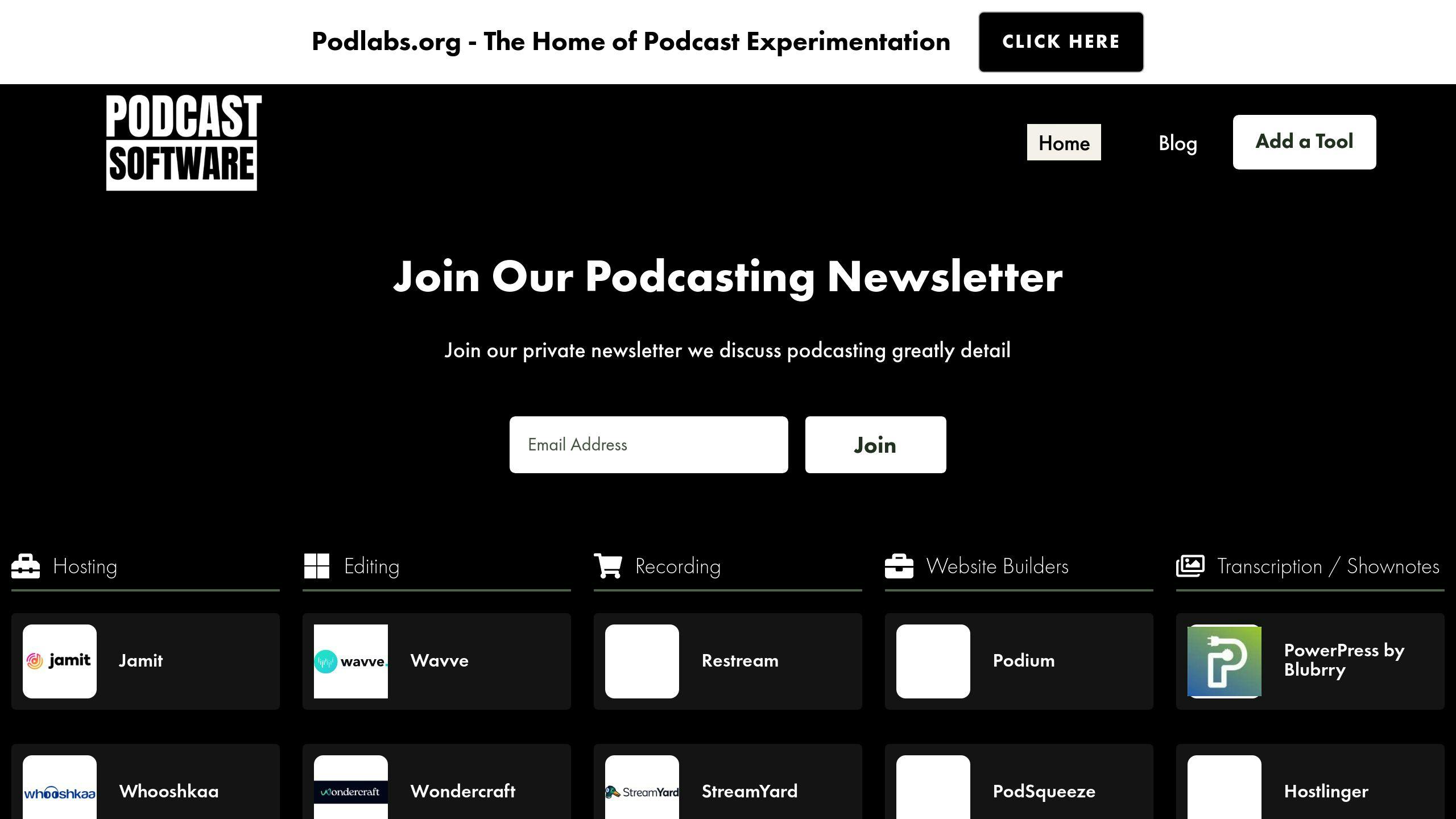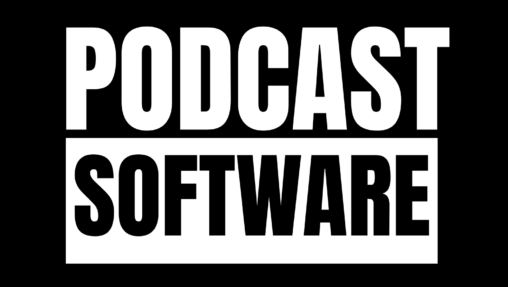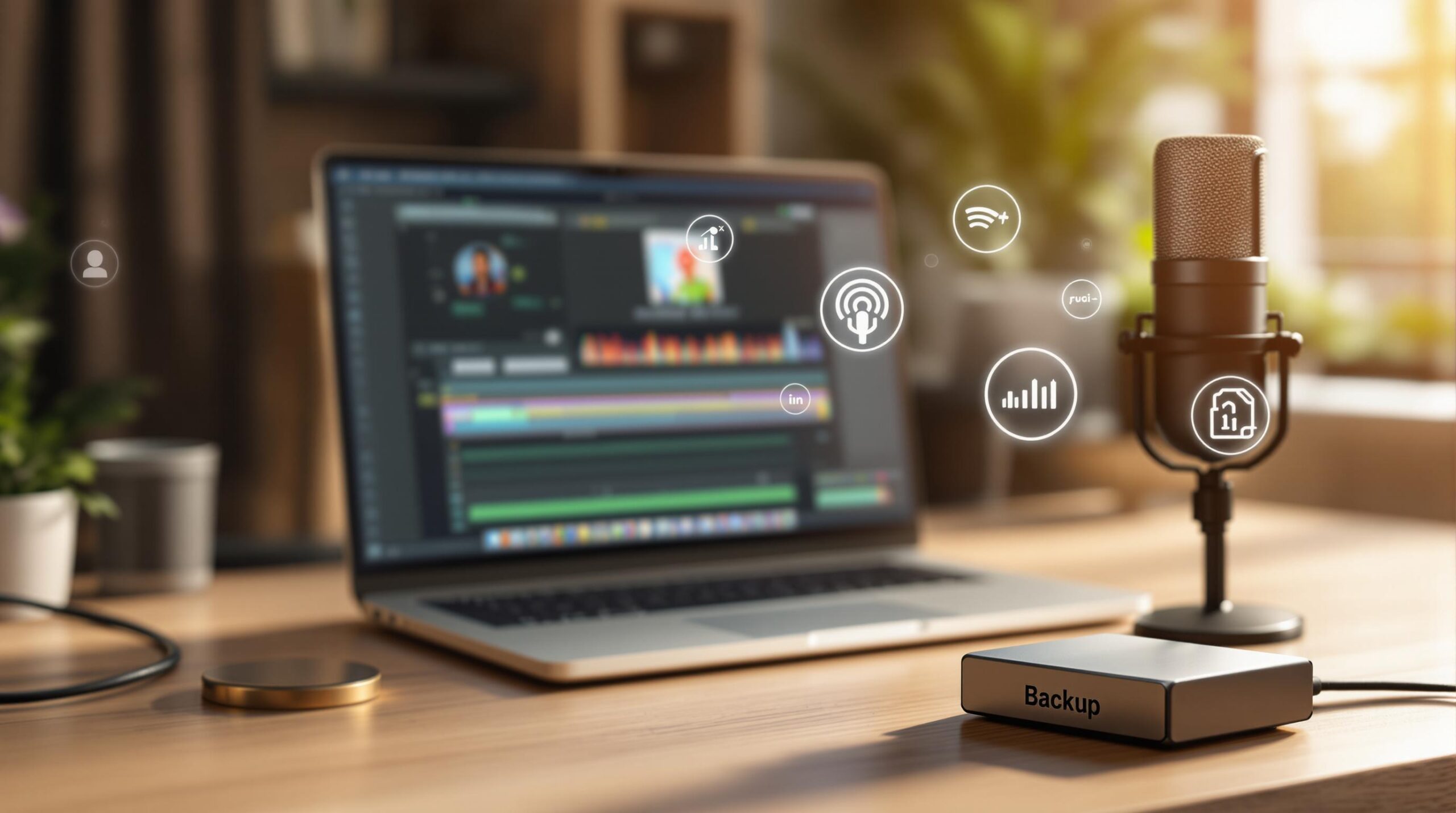Losing your podcast files can be disastrous. Whether it’s due to accidental deletion, hardware failure, or ransomware, a reliable backup system can save you from chaos. Here’s what you need to know:
-
Backup Types:
- Full Backups: Saves everything; requires more storage.
- Incremental Backups: Saves only changes; efficient but complex to restore.
- Incremental Forever: Combines full and incremental backups for long-term efficiency.
-
Storage Options:
- Local: External drives or NAS for quick access.
- Cloud: Services like Backblaze or Google Drive for remote protection.
- Hybrid: Best of both worlds using the 3-2-1 rule (3 copies, 2 media types, 1 offsite).
- Automation & Testing: Automate backups with tools like Backblaze or CrashPlan and test recovery monthly to ensure reliability.
A solid backup plan ensures your podcast stays safe, accessible, and on schedule. Let’s dive into the details to secure your content.
What Backup Type Do I Want: Full, Incremental, or Differential?
Types of Backup Approaches
Protecting your podcast content starts with understanding the different backup methods available. Here’s a breakdown of the main approaches and how they fit into podcast production workflows.
Full Backups
Full backups involve creating a complete copy of all your podcast files at a specific point in time. This includes everything – raw audio, final edits, show notes, and metadata [2].
The benefit? You can restore your entire podcast archive from a single backup if needed. However, this method requires a lot of storage and time, which can slow down workflows due to its resource-heavy nature [2].
Incremental Backups
Incremental backups save only the changes made since your last backup [2]. For podcasters releasing weekly episodes, this means backing up just the new content instead of the entire archive each time.
This approach is faster, uses less storage, and allows for selective episode restoration. The downside? Restoring your archive requires the initial full backup plus all subsequent incremental backups [3].
| Backup Type | Storage Usage | Backup Speed | Restoration Process | Best For |
|---|---|---|---|---|
| Full | High | Slow | Simple – single backup point | Entire archive protection |
| Incremental | Low | Fast | Complex – multiple backup points | Regular episode updates |
Incremental Forever Backups
This method starts with a full backup, followed by a continuous series of incremental backups. It automates the process, balancing storage efficiency with reliability [2].
Designed for podcasters with large archives, this approach reduces storage costs while providing quick access to past episodes. It’s a smart option for those managing growing collections without sacrificing the ability to restore content when needed.
Each of these methods has its strengths and trade-offs. Next, we’ll look at how to choose the best system for your podcasting needs.
Selecting a Backup System for Your Podcast
Now that you understand backup methods, it’s time to choose a system that fits your podcast’s needs.
Factors to Consider
Some systems are easier for beginners, while others demand more technical expertise. Your budget is a key factor – local storage is usually more affordable, but cloud storage offers more flexibility at a higher cost. Keep in mind that cloud storage fees can grow quickly if you’re archiving many episodes.
Think about how often you release episodes and the audio quality you produce. These factors affect your storage requirements. Also, make sure the system you pick provides recovery speeds that align with your release schedule.
Comparison of Backup Methods
Here’s a breakdown of common backup systems and how they stack up for podcasting:
| Backup Method | Best For | Storage Cost | Recovery Time | Technical Complexity |
|---|---|---|---|---|
| Full Backup | Small archives needing quick recovery | Higher | < 2 hours | Low |
| Incremental Backup | Frequent updates with limited storage | Lower | 4-8 hours | Medium |
| Hybrid Backup | Medium-sized podcasts with balanced needs | Moderate | 2-4 hours | Medium-High |
Key Considerations
- Storage and Recovery: Match your storage setup to your episode frequency and audio quality. Fast recovery is crucial for meeting deadlines.
- Technical Resources: Full backups are easier to manage but use more storage, while incremental backups save space but require more know-how.
Once you’ve chosen the right backup system, the next step is setting it up with the proper tools and storage solutions to keep your podcast secure and accessible.
sbb-itb-9f49a8d
Setting Up a Podcast Backup Solution
Local vs. Cloud Storage Options
Backing up your podcast files is essential, especially with the large audio files and frequent updates that come with podcasting. Choosing the right storage setup can make a big difference. Local storage gives you full control and quick access to your files, while cloud storage adds an extra layer of protection against physical damage and allows for remote access.
Local Storage Options
- Use external hard drives with enough capacity to handle your growing podcast archive.
- Consider Network Attached Storage (NAS) for easy team access.
- Set up RAID configurations to add redundancy and reduce the risk of data loss.
Cloud Storage Options
Cloud services like Google Drive, Dropbox, and Backblaze provide scalable, remote-access storage solutions that are ideal for podcasters.
A hybrid setup is often the best strategy. This means combining local and cloud storage, following the 3-2-1 backup rule: keep three copies of your data, store them on two different types of media, and make sure one copy is stored offsite.
Once you’ve chosen your storage methods, automate your backup process to keep everything consistent and hassle-free.
Tools for Automated Backups
Automation ensures your backups run smoothly without interrupting your workflow. Below is a comparison of some reliable tools for automating backups:
| Backup Tool | Key Features | Best For | Cost/Month |
|---|---|---|---|
| Backblaze | Continuous backup, External drive support | Solo podcasters | $7 |
| CrashPlan | Versioning, Custom retention | Small teams | $10/device |
| Google Drive | Real-time sync, Collaboration | Multi-host shows | $9.99 (2TB) |
To avoid disruptions, schedule backups during times when you’re not recording or editing your podcast.
Steps to Set Up Automated Backups
- Schedule backups for off-hours and enable notifications to keep track of their status.
- Turn on versioning to save multiple versions of each episode.
- Test your recovery process monthly to confirm your backups are working properly and up to date.
Gartner reports that IT downtime costs average $5,600 per minute [1]. For podcasters, this could mean lost episodes, missed deadlines, and disappointed listeners. A reliable backup system isn’t just about securing your files – it’s about keeping your podcast running smoothly and maintaining your reputation.
Podcast Backup Best Practices
Organizing Your Backups
Keeping your podcast backups organized is key to building a dependable archive. Use folders tailored to different content types and stick to clear naming conventions for easy identification.
Main Content Categories:
- Raw audio recordings
- Edited episodes ready for release
- Show notes and metadata
- Promotional materials and artwork
- Guest releases and legal documents
| Content Type | Backup Priority | Naming Example | Backup Frequency |
|---|---|---|---|
| Final Episodes | Highest | EP001_FINAL_DATE | Daily |
| Raw Recordings | High | EP001_RAW_GUEST | Weekly |
| Show Assets | Medium | COVER-ART_S01_V2 | Monthly |
| Documentation | Low | GUEST-RELEASE_EP001 | Monthly |
Using the 3-2-1 backup rule (three copies of your data, stored on two different types of media, with one offsite) adds an extra layer of security for critical files like final episodes and raw recordings. Once everything is organized, focus on testing your backups regularly to ensure they work when you need them.
Regular Backup Testing
Testing your backups is a must to avoid unpleasant surprises. Backup expert W. Curtis Preston, host of The Backup Wrap-Up Podcast, emphasizes that the growing risk of ransomware makes this step more crucial than ever [1].
Suggested Testing Schedule:
- Restore a full episode monthly
- Verify metadata accuracy quarterly
- Check automation processes weekly
Automated backup tools can make this process smoother by offering detailed logs and version tracking. During tests, simulate actual recovery scenarios to confirm the following:
- Audio files remain intact
- Show notes and metadata are accessible
- Promotional materials can be restored
- Guest-related documents are retrievable
Measure how long it takes to recover key files, like full episodes, to ensure your system can meet deadlines. If recovery times are too slow, it might be time to rethink your backup method or upgrade your storage tools.
With reliable tools and a solid testing routine, you can protect your podcast with less hassle and greater confidence.
Recommended Tools for Podcast Backups
Podcastsoftware.co

Protecting your podcast content starts with the right tools. Podcastsoftware.co is a go-to directory for podcast software, including backup options. It provides free, curated recommendations for tools that work well with popular hosting platforms and editing software.
Now, let’s dive into some tools and services that can help you keep your podcast content safe.
Backup Tools for Podcasters
Using a mix of cloud and local backup solutions gives you the best protection, ensuring your podcast is secure no matter what.
Cloud Storage Solutions
| Service | Storage Capacity | Key Features | Monthly Cost |
|---|---|---|---|
| Backblaze | Unlimited | Automated backups, versioning | $6 |
| Google Drive | 15GB – 2TB | Real-time collaboration, sharing | $1.99 – $9.99 |
| Dropbox | 2GB – 2TB | File sync, recovery options | Free – $11.99 |
Backblaze offers unlimited storage with automation, making it ideal for large files. Google Drive and Dropbox are great for collaboration and easy file sharing.
Local Backup Solutions
For added security, local backups like portable drives, desktop drives, or NAS devices are essential. Automated tools that handle both cloud and local backups can simplify the process, ensuring regular backups and file integrity checks.
"Start small with disaster recovery testing and gradually move to full-scale DR scenarios to ensure effective recovery capabilities" [1].
Storage Requirements Guide
| Content Type | Backup Frequency |
|---|---|
| Raw Episodes (500MB-1GB per episode) | After recording |
| Final Episodes (50-200MB per episode) | After publishing |
| Show Assets (1-2GB total) | Monthly |
| Documentation (100-500MB total) | Weekly |
Conclusion and Key Points
Backup Strategies at a Glance
Full and incremental backups each play a unique role. Full backups capture everything, offering complete archival protection, while incremental backups save time and storage by focusing only on changes. With ransomware posing a growing risk, having a solid backup plan is more important than ever.
| Backup Type | Ideal For | Benefits |
|---|---|---|
| Full Backup | Initial setups, critical moments | Complete data protection |
| Incremental | Routine updates, large libraries | Saves time and storage |
| Hybrid Approach | Balanced protection | Combines security and efficiency |
Practical Tips for Podcasters
The 3-2-1 rule is a tried-and-true method: keep three copies of your data, store them on two different media types, and ensure one copy is offsite. This approach minimizes the risk of data loss.
Here’s how to safeguard your podcast content effectively:
- Automate and Monitor: Use automated backups and keep an eye on their performance to ensure they’re running smoothly.
- Test and Encrypt: Regularly test your recovery process (aim for monthly) and encrypt your backups to keep your data safe.
"Start small with disaster recovery testing and gradually move to full-scale DR scenarios to ensure effective recovery capabilities" [1]
Platforms like Podcastsoftware.co can keep you updated on the latest backup tools. By applying these strategies and using reliable tools, you’ll ensure your podcast remains protected and accessible. A dependable backup system isn’t just a safety net – it’s a step toward securing your podcast’s future.

